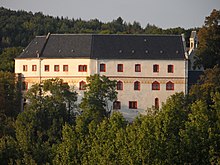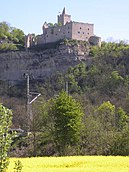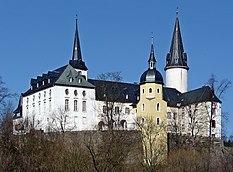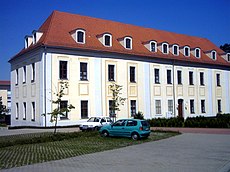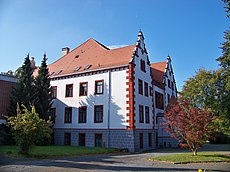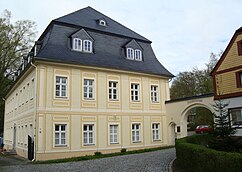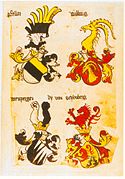Schönberg (noble family)
Schönberg is the name of an ancient Saxon nobility that can be traced back to the 13th century. Some members of the family were bishops , cardinals , bailiffs, or chamberlain . Between 1542 and 1761, several members of the von Schönberg family headed the Saxon mining administration as mining captain or chief miner.
origin
According to their own tradition, the von Schönberg family came from Schönburg Castle in the diocese of Naumburg . At the same time, the Lords and Counts of Schönburg also claim to come from this castle. In the documents of the bishops of Naumburg , from 1157 on, "Sconenbergs" are named as noble free , later only as ministerials .
Other considerations suggest that the von Rothschönberg family came from the Mark Meissen , which was called Schönberg until the 17th century .
history
Hugo von Sconenberg is then named in later documents after the Rudelsburg , where he was Burgmann . The St. Michaelskapelle in the Cistercian monastery Altzella near Nossen , consecrated in 1218, is the first known burial place of the Schönbergs, the "Schönberg Chapel". With the Sifrid von Schönberg repeatedly mentioned in documents of the Altzella monastery from 1282 to 1284 the genealogically secured line of trunks begins. Since then, the Schönbergs have been primarily a family in the Mark Meissen and Lusatia .
The first known possessions were Rothschönberg (documented since 1254) and Zschochau - after that the two main branches are called. In the 14th century - probably as a replacement for the rule Schellenberg (later Augustusburg ) - the rule Sachsenburg (1368 to 1610) and Sayda / rule Purschenstein (until 1945) were added. Caspar von Schönberg had the late Gothic Sachsenburg built on the remains of an older castle by the Saxon master builder Hans Reynhart around 1480. In Frankenberg / Sa. , which belonged to the Sachsenburg rule, Caspar von Schönberg had the Frankenberg manor , also known as the new building , built in 1553 .
In 1377 the Schönbergs acquired Reinsberg Castle , which remained in the family for over 500 years until 1945; In 1572 it was divided into Oberreinsberg and Niederreinsberg. From 1473 to 1564 they owned the Stollberg estate . Also in 1473 they acquired the dominion of Frauenstein , where they built Frauenstein Castle from 1585 , which passed into electoral ownership in 1647. From 1533 to 1907 they owned the Gelenau / Erzgeb manor . and from 1580 for almost 100 years the rule of Pulsnitz in the Lausitz. Between 1585 and 1650 the Mittelfrohna manor was owned by the family. In the 16th century, the Schonbergk family also owned the Mohrenhaus in Niederlößnitz . Between 1630 and 1807, Bieberstein Castle , near Reinsberg, was owned by the von Schönberg family, who largely renovated it in the 17th century. Between 1676 and 1720 she owned the Majoratsgut Großhartmannsdorf . In 1797 the family also acquired the ruins of the Rudelsburg , on which they had served as ministerial service at the beginning of their history in the Middle Ages , and made them a Fideikommiss (the Kösener Seniors' Convents Association was founded here in 1848 ; the castle was expropriated in 1945).
Hanns Heinrich Caspar Christoph Graf von Schönberg (born April 9, 1924, Wasserjenisch, Silesia) was adopted on March 15, 1939 by his uncle Karl Detlev Siegfried Sahrer von Sahr at Dahlen Castle and, like his descendants, bears the name Sahrer without objection under nobility law by Sahr von Schönberg . Dahlen Castle in northern Saxony was expropriated in 1945 and burned down in 1973. Descendants acquired the neighboring Leuben Castle in 2017 .
In 1945 the descendants of Sifrid are still in Rothschönberg (since approx. 1250), Purschenstein (before 1389), Ober- and Niederreinsberg (1377), Wilsdruff (approx. 1420), Limbach (1445), Herzogswalde (1445), Niederzwönitz (1473, the mansion reacquired 1992), Krummenhennersdorf (1458–1601; 1800), Thammenhain (1666, reacquired after 1990), Bornitz (1669), Tanneberg (1675), Reichstädt (1717, reacquired 1998), Kreipitzsch with the Rudelsburg (1797) and Pfaffroda (after 1352; in the possession of an adopted son Alfons Diener von Schönberg since 1917, reacquired from his descendants in 2017) and Mockritz (1856; in the possession of an adopted son Hendrik Camp von Schönberg since 1925, reacquired in 1993 by Theda von Kuenheim, née Camp von Schönberg and Eberhard von Kuenheim ).
The von Schönberg family was one of the most widely branched and wealthy families of the Saxon nobility. It remained so until the expropriation without compensation through the land reform of 1945. From 1989 some members or relatives of the family returned to Saxony (to Thammenhain , Reichstädt , Niederzwönitz and Pfaffroda ). The permanent exhibition "Searching for traces in Saxony: The von Schönberg family in eight centuries" , with numerous family portraits, is shown at Nossen Castle .
Family owned goods until 1945 (selection)
Rothschönberg Castle , headquarters from 1254
Reinsberg Castle
Wilsdruff Castle
Good Limbach
Herzogswalde Castle
Gut Tanneberg
Good Mockritz
Good Kreipitzsch
- Bought back after 1990
Thammenhain Castle
Gut Niederzwönitz
coat of arms
The coat of arms shows in gold a lion divided by red and green . On the helmet with red and gold covers a red lion's trunk.
Coat of arms in the Ingeram Codex from 1459
Coat of arms from Siebmacher's coat of arms book from 1605
Coat of arms graphic by Otto Hupp in the Munich calendar of 1903
Personalities

Bishops and cardinals
- Dietrich von Schönberg , 1370 Bishop Elect of Meißen
- Caspar von Schönberg , 1451–1463 Bishop of Meißen
- Dietrich III. von Schönberg , 1463–1476 Bishop of Meißen
- Dietrich IV. Von Schönberg , 1481–1492 Bishop of Naumburg
- Johann III. von Schönberg , 1483–1492 coadjutor of Naumburg and 1492–1517 bishop of Naumburg
- Nikolaus von Schönberg (1472–1537), traveled to Europe as Archbishop of Capua and papal envoy, member of the College of Cardinals in Rome and twice for papal election
- Joseph Anton Baron of Delmestri von Schönberg (1672–1721), Bishop of Trieste (1720/21)
- Lucas Sartorius Baron of Delmestri von Schönberg (1679–1739), Bishop of Trieste (1723–1739)
Chief Miners of the Ore Mountains in Freiberg
- Wolf von Schönberg (1518–1584), captain
- Christoph von Schönberg (1554–1608), Saxon mining captain
- Georg Friedrich von Schönberg (1586–1650), one of Freiberg's defenders against the Swedes in the Thirty Years' War , founder of the hereditary burial at Freiberg Cathedral in the Annenkapelle
- Caspar von Schönberg (1621–1676), son of Georg Friedrich von Schönberg, built the castle in Pfaffroda and left the burial place in the Annenkapelle.
- Abraham von Schönberg (1640–1711), is considered the most important of the Oberberg captains. In 1693 his "Detailed Mountain Information" was published. He was the initiator of the Freiberg scholarship fund and is therefore considered to be the “spiritual father” of the establishment of the Freiberg Bergakademie , which he no longer lived to see. He officially introduced the miner's greeting Glückauf . His tomb is located in Freiberg Cathedral .
- Curt Alexander von Schönberg (1703–1761), chamberlain from Electoral Saxony, chief miner and Russian general miner director
French line
- Caspar von Schönberg ad H. Schönau [Gaspard de Schomberg, Comte de Nanteuil-le-Haudouin] (1540-1599). He played a decisive role in Henry IV of France converting to the Catholic faith and thus giving France back her inner peace. He helped prepare the Edict of Tolerance of Nantes (1598). His brother Hans Wolf von Schönberg was also temporarily in French service, but then returned to Saxony.
- Henri de Schomberg , Count of Nanteuil-le-Haudouin and Durtal [Heinrich von Schönberg] (1573–1632), son of Caspar von Schönberg. As surintendant des finances and marshal, he was one of the most important men in France at the time. Cardinal Richelieu said of him: “God distinguished him in great state events, the most important events of our century; Schomberg was a nobleman and famous for his loyalty to Germany. As surintendant of finances, he demonstrated the old integrity that no longer seemed from that time. "
- Charles de Schomberg , Duke of Halluin [Karl von Schönberg] (1601–1656); Son of Henri. French general and Marshal of France.
Henri de Schomberg , Count of Nanteuil-le-Haudouin and Durtal (Heinrich von Schönberg) (1573–1632), Marshal of France
Charles de Schomberg , Duke of Halluin (Karl von Schönberg) (1601–1656), Marshal of France
Further representatives according to lines and branches
- Dietrich von Schönberg on (Roth-) Schönberg
- Nikolaus von Schönberg (1472–1537), cardinal
-
Heinrich von Schönberg (1500–1575), court marshal of the Electorate of Saxony
- Johann Friedrich von Schönberg (1543–1614), German writer, author of the Schildbürgergeschichten
- Caspar von Schönberg (1504–1562), knight
- Caspar von Schönberg (1526–1586)
- Hanns Heinrich von Schönberg (1573–1636), Lord of Limbach
- Caspar Dietrich von Schönberg (1599–1673)
-
Hans Wolf von Schönberg (house marshal) (1648–1712), house marshal of Saxony-Weißenfels and councilor
- Adolph Ferdinand von Schönberg (1685–1758)
- Christian Ferdinand von Schönberg (1720–1756)
-
Ferdinand Ludwig Christian von Schönberg (1750–1829), electoral governor and manor owner
-
Franz von Schönberg (1795–1861), chamberlain and manor owner
- Haubold von Schönberg (1821-1897)
- Karl von Schönberg (1872–1914), officer in the Imperial Navy , posthumously sea captain
- Wolf Ferdinand Franz von Schönberg (1825–1911)
- Walter von Schönberg (1861–1926), Prussian major general and legal knight of the Order of St. John
- Bernhard von Schönberg (1827–1902), President of the Saxon Chamber of Accounts
- Haubold von Schönberg (1821-1897)
-
Franz von Schönberg (1795–1861), chamberlain and manor owner
-
Ferdinand Ludwig Christian von Schönberg (1750–1829), electoral governor and manor owner
- Alexander Christoph von Schönberg (1724–1801)
- August Friedrich Christoph von Schönberg (1763-1832)
- Carl Friedrich Christoph von Schönberg (1801–1875)
- Otto Ludwig Christof von Schönberg (1824–1916)
- August Heinrich Christoph von Schönberg (1828–1889)
- Georg Emil Christoph von Schönberg (1880–1948)
- Otto-Friedrich von Schönberg (1924–2008), German politician (DP, CDU), MdL
- Georg Emil Christoph von Schönberg (1880–1948)
- Carl Friedrich Christoph von Schönberg (1801–1875)
- August Friedrich Christoph von Schönberg (1763-1832)
- Christian Ferdinand von Schönberg (1720–1756)
- Adolph Ferdinand von Schönberg (1685–1758)
- Hans Friedrich von Schönberg (1655–1676) , electoral Saxon truchess and manor owner
-
Hans Wolf von Schönberg (house marshal) (1648–1712), house marshal of Saxony-Weißenfels and councilor
- Caspar Dietrich von Schönberg (1599–1673)
- Hanns Heinrich von Schönberg (1573–1636), Lord of Limbach
- Lorenz von Schönberg (1532 / 1535–1588), electoral Saxon chief miner and manor owner
- Caspar von Schönberg (1526–1586)
-
Wolf von Schönberg (1518–1584), general in Electoral Saxony, governor and captain
-
Hans Wolf von Schönberg (1539–1603), Elector of Saxony politician
- Caspar von Schönberg (politician) (1570–1629), President of the Electoral Saxon Court of Appeal
- Caspar von Schönberg (1540–1599), French officer
-
Christoph von Schönberg (1554–1608), mining captain of the Electorate of Saxony
- Andreas von Schönberg (1600–1688), electoral secretary and war councilor, sergeant-general and high commanding officer
-
Hans Wolf von Schönberg (1539–1603), Elector of Saxony politician
- Heinrich von Schönberg (1549–1616), councilor and governor
- George d. J. von Schönberg (1554–1614), chamberlain
-
Georg Friedrich von Schönberg (1586–1650), minister and governor of the Electorate of Saxony
-
Caspar von Schönberg (1621–1676), governor of the Electorate of Saxony
- Caspar von Schönberg (1660–1689)
- Caspar Dietrich von Schönberg (1684–1730)
- Caspar Dietrich von Schönberg (1713–1753)
- Curt Adolph Dietrich von Schönberg (1749–1799), chamberlain from the Electorate of Saxony and owner of the manor
- Caspar Dietrich von Schönberg (1713–1753)
- Caspar Dietrich von Schönberg (1684–1730)
- Caspar von Schönberg (1660–1689)
-
Gotthelf Friedrich von Schönberg (1631–1708), Chamberlain of Electoral Saxony
- Caspar von Schönberg (1679–1733), Chamberlain of Electoral Saxony
-
Gotthelf Friedrich von Schönberg (1681–1745), Chamberlain of Electoral Saxony
- Rudolph Dietrich von Schönberg († 1789), chamberlain of the Electorate of Saxony and district chief
-
Caspar von Schönberg (1621–1676), governor of the Electorate of Saxony
-
Antonius von Schönberg (1588–1638), Chamber and Councilor of Saxony-Altenburg
- Hans Dietrich von Schönberg (1623–1682), Saxon-Altenburg secret councilor and chancellor
-
Georg Friedrich von Schönberg (1586–1650), minister and governor of the Electorate of Saxony
- Andreas von Schönberg (feudal man) (presumably 1565–1587), feudal lord of the Electorate of Saxony
- Wolf Georg von Schönberg (1567–1619)
- Christian Johann von Schönberg (1608–1672), electoral Saxon secret council and state elder of Upper Lusatia and manor owner
- Abraham von Schönberg († 1639), Lord on Frauenstein
- Caspar Abraham von Schönberg (1637–1703), Privy Councilor and Chancellor
- Abraham von Schönberg (1640–1711), chief miner
- Hans Wolf von Schönberg (governor) (1587–1645), German governor of Upper Lusatia
- Nicol von Schönberg (1603–1659), senior and district tax collector from the Electoral Saxony
- Hans Georg Schönberg (1610–1676), lord of Wingendorf
-
Adam Friedrich von Schönberg (1654–1707), Privy Councilor and Chamberlain
-
Adam Friedrich von Schönberg (1688–1751), real secret councilor and chief tax collector and manor owner
-
Heinrich Wilhelm von Schönberg (1723–1763), royal Polish and electoral Saxon district chief and manor owner
- Friedrich Alexander von Schönberg (1754–1803), chamberlain to the Elector of Saxony, chief tax collector and manor owner
- Carl August von Schönberg (1725–1806), chamberlain to the Elector of Saxony
-
Heinrich Wilhelm von Schönberg (1723–1763), royal Polish and electoral Saxon district chief and manor owner
- Curt Alexander von Schönberg (1703–1761), chamberlain from Electoral Saxony, chief miner and Russian general miner director
-
Adam Friedrich von Schönberg (1688–1751), real secret councilor and chief tax collector and manor owner
-
Adam Friedrich von Schönberg (1654–1707), Privy Councilor and Chamberlain
- Wolf Rudolph von Schönberg (1668–1735), chamberlain and governor
- Adam Rudolph von Schönberg (1712–1795), General Postmaster of the Electorate of Saxony , close confidante of the Duchess of Saxony-Weissenfels
- Johann Wilhelm Traugott von Schönberg (1721–1804), senior administrator of the Margraviate of Upper Lusatia
- Helena Dorothea von Schönberg (1729–1799), successfully requested Elector Friedrich August II of Saxony to raise Limbach to a market town .
- Peter August von Schönberg (1732–1791), Herr auf und zu Luppa , Schmochtitz and Arnsdorf , Saxon Elector House Marshal under Friedrich August II. And Friedrich August III. , from 1768 to 1791 landowner of the village Spremberg and landlord and court lord, church and school patron of the small town Neusalza , father of Countess Auguste Charlotte von Kielmannsegge
- Adam Gotthilft von Schönberg (1763–1821), chief chef of the Lausitz, inventor of the "Moritzburger mountain roll"
- Moritz Haubold von Schönberg (1770–1860), Upper President of the Prussian provinces of Silesia and (Rear) Pomerania
Not related to the Saxon Schönbergs representative of the Württemberg personal nobility
- Gustav von Schönberg (1839–1908), German economist
Unrelated families with similar names
- Schönberg / Schomberg / Schönburg auf Wesel , Rhineland noble family:
To this (unrelated) family belonged Hans Meinhard Graf von Schönberg (1582–1616), electoral Palatinate and Electorate Brandenburg field chief and court master of Elector Friedrich V of the Palatinate and his son Friedrich von Schomberg (Frédéric-Armand de Schomberg), (1615– 1690), Marshal of France, General in Brandenburg and Great Britain, 1st Duke of Schomberg and his son Meinhard von Schomberg (Ménard de Schomberg) (1641–1719), English general, 3rd Duke of Schomberg, 1st Duke of Leinster, 2. Count de Mértola (via his daughter Mary, born 1692, ancestor of the Counts of Degenfeld -Schonburg)
- Counts and princes of Schönburg (Saxon-Thuringian noble family ), who also derive their origin from Schönburg Castle on the Saale.
Notes and sources
- ↑ The Mittelfrona manor at www.sachsens-schlösser.de
- ↑ website Mayoratsguts Großhartmannsdorf
- ^ Nossen Castle - events and exhibitions
- ↑ From members of the family v. Schönberg and the related family Diener von Schönberg (Pfaffroda)
literature
- Matthias Donath : Red-green lions. The von Schönberg family in Saxony (Adel in Sachsen, vol. 4), Meißen 2014.
- Albert Fraustadt : History of the Schoenberg family, Meissnian tribe , 2 vols., Leipzig 1878. ( digitized , digitized )
- Genealogical handbook of the nobility , Vol. 34, 1965.
- Sächsisches Staatsarchiv (Ed.): The noble family von Schönberg in Saxony. Specialist colloquium of the Saxon State Archives, State Archives Leipzig October 22, 2010 , Dresden 2011.
- Maria Emanuel Herzog zu Sachsen : Patronage in Saxony , Verlag Weidlich, Frankfurt am Main 1968, separate chapter on the von Schönberg family, pp. 14, 18, 26, 34–39, 45
- Gothaisches genealogical pocket book of noble houses , 1904, p. 735ff , 1906, p. 718ff

